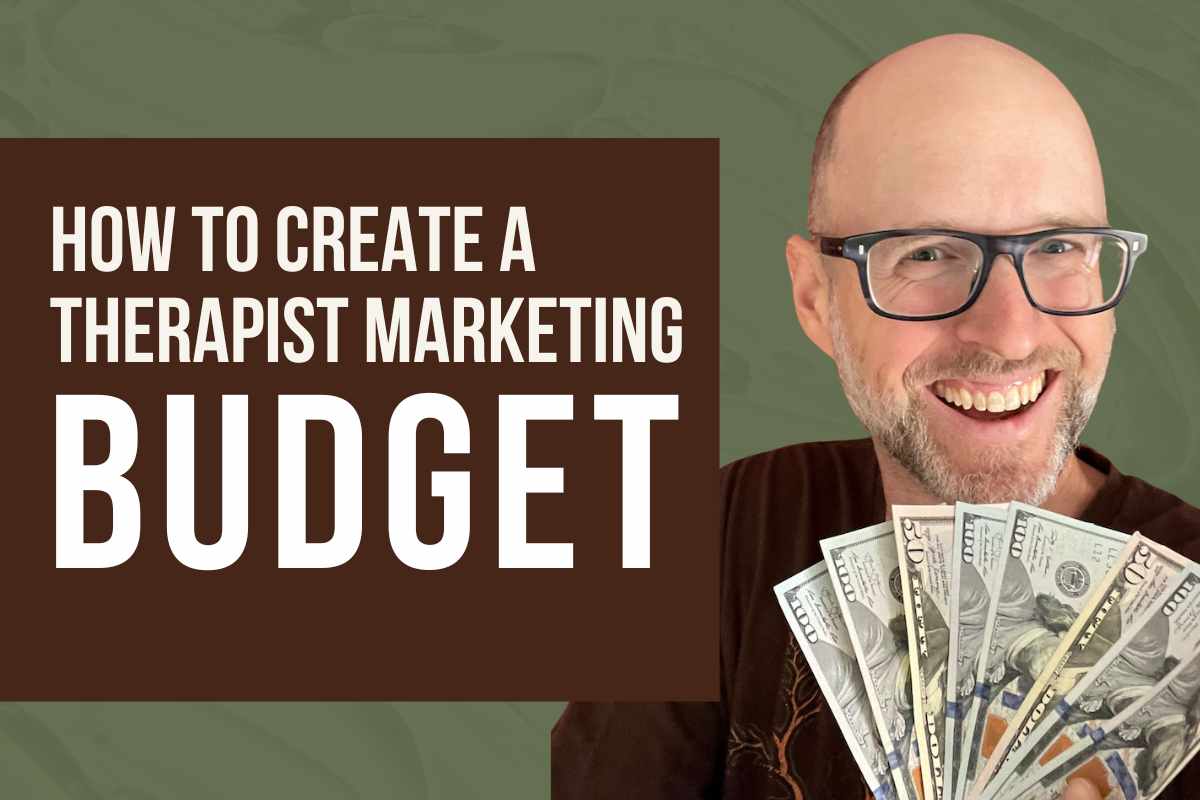How to Make a Therapist Marketing Budget: the Cliff’s Notes Version
Your therapist marketing budget should be between 5-15% of your desired revenue.
If you want to earn $250,000/year, you should budget an average of $2,500/month to get there. Yet, 79% of therapists spend less than $100/month on marketing¹. Then, they wonder why their caseloads remain empty.
Here are the key numbers you’ll need to know when creating a therapist marketing budget:
- Current business and personal expenses
- Annual revenue goal
- Session rate
- Average number of sessions per client
- Client termination rate
- Lifetime value of a client
- How many weeks of vacation you want each year
It’s also worth noting that the concept of ROI (return on investment) is completely subjective. Some experts say a good ROI for your therapist marketing budget is 5:1. Others say 10:1. However, those numbers don’t take into account the long-term nature of your clients … or, the long-term effects of efforts like SEO and social media. More on that later.
The Problem With Setting a Budget For Your Therapist Practice
Tell me if this sounds familiar. You need more clients but you don’t know how to get them. You want to “do marketing” but have no idea how much to spend or how to create a marketing budget for therapists. Some agency told you it costs $1,000 just for them to manage your marketing … and you still need to pay for ads. How can you justify that expense when you are barely making ends meet?
Most therapists I talk to find themselves in the same situation. It’s like the chicken and the egg. Fundamentally, you understand that it takes money to get more clients. But, until you have more clients you don’t have the funds to invest. So, you’re left spinning your head, subscribing to dozens of therapist marketing newsletters, and hoping a genie magically fills your caseload.
There is a lot to consider when creating a marketing budget for therapists. Fortunately, I have decades of experience working with therapists and have a unique understanding of what it takes to succeed. In this article, I’ll walk you through the exact steps to set a marketing budget for a profitable practice.
5 Key Areas to Allocate Your Marketing Spend
A well-rounded marketing budget for a psychotherapy practice should balance immediate visibility through paid ads and directory listings with long-term sustainable visibility through SEO. It also needs to include someone to do the technical work for you, lest you get bogged down in the inefficient mire of DIY marketing.
Therapist Marketing Agencies and Freelancers
Professionals (like the marketing for therapists team at Goodman Creatives) offer specialized skills and experience, providing insights and strategies that might be overlooked otherwise. Moreover, they bring time efficiency, allowing therapists to focus on core services, and offer customized solutions tailored to the unique needs of the practice.
Be sure to balance the cost against the potential increase in clients and revenue. Also, make sure whomever you choose aligns with your values and has a proven track record in therapist marketing.
Industry-Standard Rates
$500 – $1,000 for 1 service
$2,500+ for comprehensive management
Paid Advertising on Google & Facebook
Google Ads for therapists ensure that your practice shows up in front of people who are actively looking for therapy services. Facebook and other social media are like billboards on the side of the road. You might get an occasional new client from the first ad view … but it’s usually about building relationships and getting clients later. Finally, consider using retargeting ads on Google and Facebook to show targeted ads to people who have visited your website or interacted with your content.
Suggested Therapist Advertising Budget
Google Ads: $300/month for every new client you need
Facebook: $100/month for retargeting ads or $500/month if you’re running a funnel
Search Engine Optimization (SEO)
Effective SEO for therapists increases your practice’s visibility on search engines, making it easier for potential clients to find you. Unlike paid ads, the benefits of SEO are long-lasting, offering a cost-effective strategy over time. However, SEO is a long-term investment. It can often take 8-12 months of ongoing effort to really see results. In terms of priority, it’s a good idea to invest in SEO as much as you can, but not at the expense of Google Ads, which bring you clients now.
Suggested Therapist SEO Budget
$500/month for slow growth. $1,000+ for faster growth
Therapist Directory Sites
Sites like Psychology Today, GoodTherapy, ZocDoc, Bark, and TherapyDen are often the first stop for potential clients seeking therapy services, providing targeted exposure to a relevant audience. As long as you have a good profile, they are worth investing in.
Suggested Marketing Budget
$100/month, spread out amongst 3-4 sites
$60/lead with ZocDoc
Apps & Digital Infrastructure
Websites for therapists. Email newsletters. Social media management. CRM. Automated funnels. It takes a collection of interconnected apps to run a modern practice. hese tools not only streamline processes but also provide valuable data insights into client behavior and preferences. High-quality, user-friendly apps also contribute to the professional image of a practice, enhancing client trust and satisfaction. Account for what you use now and add in what you may need later when making a budget for your therapy practice.
Suggested Therapist Marketing Budget
$300/month — at least, that’s what we charge at Goodman Creatives for our all-in-one Therapist Marketing Hub.
Measure the ROI (Return on Investment) to Ensure Success
One way to evaluate the success of your marketing is to track your return on investment (ROI). This involves comparing the amount of money you are spending on marketing to the amount of revenue you are generating as a result of that marketing.
However, the reality of determining the ideal Return on Investment (ROI) for a marketing budget can be a bit subjective. Your numbers largely depend on the specific goals, industry standards, and financial health of your practice. However, there are some general principles and expectations you can consider:
- Positive ROI: At its core, a successful marketing strategy should generate more revenue than it costs. You want your ROI to be positive, meaning the income generated from new clients acquired through marketing exceeds the cost of the marketing itself.
- Context Matters: For a psychotherapy practice, the calculation should factor in the lifetime value of a client. If a new client costs $100 to acquire but provides $1,000 in revenue over time, that’s a strong ROI.
- Sustainability and Growth Goals: Your desired rate of growth influences your acceptable ROI. If you’re aiming for rapid growth, you might accept a lower ROI initially, because you’re investing in future market positioning. Conversely, if you’re focused on sustainable, slow growth, you might aim for a higher ROI to ensure profitability.
- Budget Allocation: The percentage of your revenue allocated to marketing can also influence what ROI is acceptable. If you’re spending a significant portion of your revenue on marketing, you’d expect a higher ROI compared to a more modest marketing budget.
- Trial and Error: Marketing often involves experimentation. You might start with a target ROI based on industry standards or advice from other professionals, then adjust based on the actual performance of your marketing efforts.
- Long-Term Value vs. Short-Term Gains: Some marketing strategies may have a lower immediate ROI but contribute to long-term brand building and client loyalty, which can be more valuable in the long run.
Remember, the most important aspect is to continuously monitor and adjust your marketing strategies based on the ROI you’re achieving, ensuring it aligns with your overall business goals.
Adjust Your Strategies Based on ROI and Performance
Once you have tracked your ROI for various marketing strategies, you can use that information to adjust your marketing strategies based on their performance. For example, if you find that your Google Ads campaigns are generating a high ROI, but your social media campaigns are not, you may want to shift some of your marketing budget from social media to Google Ads.
It is important to remember that tracking ROI is not the only way to measure the success of your marketing efforts. You should also be tracking other metrics, such as website traffic, click-through rates, and conversion rates. This will give you a more complete picture of how your marketing strategies are performing.
Overall, tracking the success of your marketing efforts is crucial to setting a marketing budget for your psychotherapy practice. By tracking your ROI and other metrics, you can make informed decisions about where to allocate your marketing budget and adjust your strategies to maximize your return on investment.
Calculate the Lifetime Value of a New Client
One of the most important metrics that you need to consider when setting a therapist marketing budget for your practice is the lifetime value (LTV) of a new client. By understanding how much a new client is worth to your business over the long term, you can make informed decisions about how much to invest in marketing and client acquisition. It also helps you get a better idea of a true ROI on your therapist marketing budget.
How Many Sessions Does An Average Client Have?
To calculate the LTV of a new client, you first need to determine how many sessions an average client has with your practice. This will vary depending on your specialty and the needs of your clients. For example, if you specialize in short-term therapy, your clients may only have a few sessions with you. On the other hand, if you specialize in long-term therapy, your clients may have dozens or even hundreds of sessions with you.
Once you have a good idea of how many sessions an average client has, you can multiply this number by the average fee you charge per session to get the total revenue you can expect from a new client.
How Often Does Your Ideal Client Bring in Referrals?
Another factor to consider when calculating the LTV of a new client is how often your clients bring in referrals. If you have a high referral rate, you can expect to earn more revenue from each new client over time. This is because referrals are more likely to become long-term clients and are often more willing to pay for additional services.
How Accurate is the LTV Formula?
It’s important to keep in mind that the LTV formula is not an exact science. There are many factors that can influence the lifetime value of a new client, including changes in your fees, the quality of your services, and the overall market demand for your specialty.
However, by using the LTV formula as a starting point, you can get a good idea of how much you can expect to earn from a new client over time. This can help you make informed decisions about how much to invest in marketing and client acquisition, and can ultimately help you grow your psychotherapy practice.
Reduce Your Marketing Budget With a Dream Client & Niche
Having a clear understanding of your dream client and niche is an essential component of effective marketing for psychotherapy practices, particularly in its capacity to reduce expenses and lowering your therapist marketing budget. It reduces the scattergun approach of trying to appeal to everyone and instead directs resources to strategies that are more likely to attract and retain the clients who will benefit most from the practice’s services.
A well-defined dream client and niche facilitate the creation of more compelling and relevant content, whether for a website, social media, or other advertising materials.This precision not only saves money but also enhances the overall effectiveness of the practice’s marketing efforts.
Content that speaks directly to the needs, challenges, and aspirations of a specific group is more likely to engage and convert potential clients. This lowers your therapist marketing budget.
This focused content creation is not only more effective but also more cost-efficient, as it eliminates the need for a wide array of diverse and less targeted materials. Instead, marketing efforts can be focused on channels and messages that resonate directly with the intended clientele.
Analyze Your Local Market to Stay Ahead of the Competition
While it’s not an essential part of creating a marketing budget for therapists, it’s important to understand what your competition is doing. Start by researching other therapists and mental health professionals in your area. Do a Google search and see what comes up. Keep an eye out for insights into the specific needs, preferences, and behaviors of your dream clients. This will help you identify their strengths and weaknesses, as well as their marketing strategies.
For instance, if your research reveals a growing need for anxiety management among young professionals in your area, you can focus your therapist marketing budget on addressing this need. This level of specificity in your marketing approach not only enhances the effectiveness of your campaigns but also helps in establishing your practice as a go-to resource for specific mental health needs.
By understanding what other therapists in your area are offering, their marketing tactics, and their client base, you can identify gaps in the market and areas where you can differentiate your services.
If you notice most competitors focus on general therapy, running Google Ads or focusing your SEO efforts in a niche like relationship counseling or mindfulness-based therapy could set you apart. Keeping an eye on your competitors helps you stay informed about the evolving market trends and adapt your strategies accordingly. This continuous process of learning and adaptation ensures that your practice remains relevant and competitive in an ever-changing market.
3 Reasons to Spend More Money on Marketing
Investing more in marketing can be a strategic decision for a psychotherapy practice, and there are several compelling reasons to consider doing so:
1. Accelerated Growth and Expansion
If your goal is to rapidly grow your client base or expand into new markets or services, increasing your marketing budget can significantly speed up this process.
More funds allocated to marketing mean you can reach a larger audience, increase your brand visibility, and attract more clients in a shorter time frame. This is especially important if you’re launching new services or entering a competitive market where establishing a strong presence quickly is crucial.
2. Enhancing Brand Recognition and Reputation
A higher marketing budget allows for more sophisticated and widespread branding efforts. This could include high-quality content creation, professional branding services, and a stronger online presence. Investing in building a strong, recognizable brand is crucial for long-term success. It not only attracts new clients but also helps in retaining existing ones by reinforcing the practice’s credibility and professionalism.
3. Leveraging Expensive but Effective Marketing Channels
Certain marketing channels and strategies, though costly, have proven to be highly effective. These might include targeted online advertising, attending and presenting at industry conferences, sophisticated SEO strategies, or high-quality video marketing.
These methods often require a significant investment but can yield a high return in terms of client acquisition and brand positioning. By allocating more funds to your marketing budget, you can take advantage of these powerful tools, which might otherwise be out of reach.
In summary, increasing the marketing budget can be a strategic move for a psychotherapy practice, facilitating rapid growth, enhancing brand presence, and allowing access to high-impact marketing channels. It’s a decision that should be weighed against the practice’s current financial situation, long-term goals, and the potential return on investment.
Frequently Asked Questions
What percentage of revenue should be allocated to marketing for a new psychotherapy practice?
As a general rule of thumb, the suggested budget allocation for a new psychotherapy practice should be around 5-10% of its revenue to marketing. However, the exact percentage may vary depending on factors such as the practice’s location, target audience, and competition. It’s important to strike a balance between investing enough in marketing to attract new clients and not overspending to the point of diminishing returns.
How can a psychotherapy practice determine the most cost-effective marketing strategies?
One way to determine the most cost-effective marketing strategies is to track the return on investment (ROI) for each strategy. This involves measuring the revenue generated from each marketing effort against the cost of implementing it. Another way is to conduct market research to identify the most effective channels for reaching your target audience. By gathering data on your audience’s preferences and behaviors, you can focus your marketing efforts on the channels that are most likely to yield results.
What are the essential marketing expenses for a startup psychotherapy practice?
Some essential marketing expenses for a startup psychotherapy practice include website development and maintenance, search engine optimization (SEO), social media advertising, and local directory listings. It’s also important to invest in branding and design to establish a professional and cohesive image for your practice.
How can a psychotherapist adjust their marketing budget as their practice grows?
As your practice grows, you may need to adjust your marketing budget to reflect changes in your revenue, target audience, and competition. There are many factors influencing the marketing budget. One way to do this is to track your marketing ROI and adjust your spending accordingly. You may also need to experiment with new marketing strategies to stay ahead of the competition and reach new audiences.
What are some common marketing mistakes to avoid in a psychotherapy practice budget?
Some common marketing mistakes to avoid in a psychotherapy practice budget include overspending on ineffective marketing channels, failing to track ROI, neglecting to invest in branding and design, and failing to adapt to changes in the market or your audience’s preferences.
How often should a psychotherapy practice review and revise its marketing budget?
A psychotherapy practice should review and revise its marketing budget on a regular basis, such as quarterly or annually. This allows you to stay on top of changes in the market, your competition, and your audience’s preferences, and adjust your marketing strategy accordingly.
What is the Right Marketing Budget For a Psychiatry Practice
The rules for psychiatrists are the same as for psychologists, therapists, and all other mental health practitioners. Plan to invest between 5-15% of your desired revenue on a mix of advertising, systems, directory sites, and people to manage your marketing.
What are Cost-Effective Allocation Strategies For a Therapist Marketing Budget?
To get the most out of your marketing budget, it’s important to be strategic in how you allocate your funds. Here are some cost-effective allocation strategies to consider:
- Focus on digital marketing channels, such as social media, email marketing, and search engine optimization (SEO).
- Use free or low-cost marketing tools, such as Google My Business, Yelp, and local directories.
- Leverage your existing client base by offering referral incentives and encouraging online reviews.
- Partner with other local businesses or organizations to cross-promote each other’s services.

















